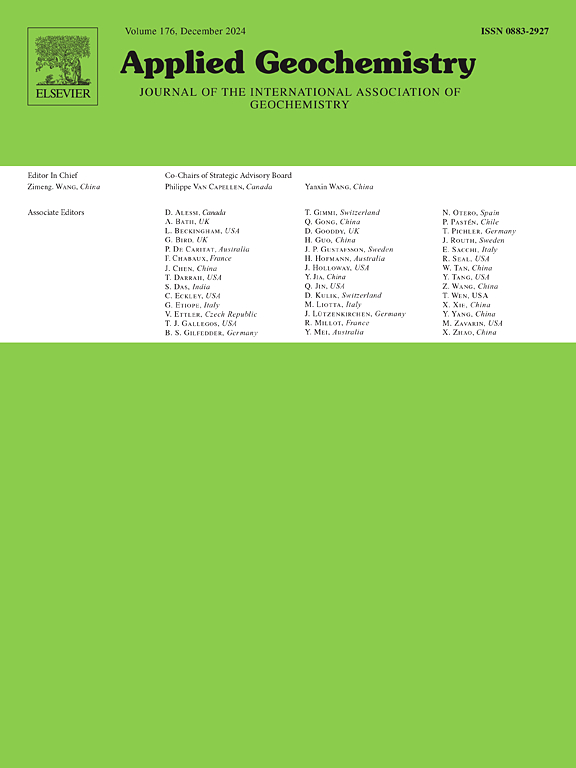比较不同采样方法的温室气体稳定同位素:含水层地下水和煤层气生产水
IF 3.4
3区 地球科学
Q1 GEOCHEMISTRY & GEOPHYSICS
引用次数: 0
摘要
甲烷和二氧化碳在含水层中无处不在,由于它们在全球变暖中的作用而受到越来越多的关注。甲烷和二氧化碳的稳定碳、氢同位素δ13C-CH4、δ13C-CO2和δ2H-CH4可以为地下水天然气的来源提供信息,并确定其成因是通过热成因还是不同的生物成因(微生物)过程。例如,这可以告知气藏与上覆含水层之间是否存在连通性。这些稳定同位素也用于一系列环境中的监测,例如,在二氧化碳地质储存期间。将地下水抽到地表会导致降压和气体起泡,因此,已知采样方法(即如果样品接触大气)会影响测量的溶解气体浓度;然而,样品采集对稳定同位素的影响仍未得到解决。气体稳定同位素可以在现场收集在一系列样品容器中,包括溶解气体在检测瓶或等容瓶中;或气体袋或气瓶中的游离气体。收集了不同钻孔的含水层地下水、煤层气生产水和煤层气游离气,进行了δ13C-CH4、δ13C-CO2和δ2H-CH4分析。测试瓶和等烧瓶的溶解气体样品对主要进行了比较,并且通常具有良好的低方向百分比变异。来自其他容器(包括气瓶或气袋中的游离气体)的样品对子集也与通常测量的一致的稳定同位素特征进行了比较。这带来了信心,使用不同的样品容器,如果需要不同的现场条件和情况。本文章由计算机程序翻译,如有差异,请以英文原文为准。

Comparing greenhouse gas stable isotopes from different sampling methods: Aquifer groundwater and coal seam gas production waters
Methane and carbon dioxide are ubiquitous in aquifers and are gaining increased attention through their role in global warming. The stable carbon and hydrogen isotopes of methane and carbon dioxide, δ13C–CH4, δ13C–CO2 and δ2H–CH4, can inform on the sources of gas in groundwater and determine if the origin is via thermogenic or different biogenic (microbial) processes. This can, for example, inform if there is connectivity between gas reservoirs and overlying aquifers. These stable isotopes are also used in monitoring in a range of settings, for example, during CO2 geological storage. The pumping of groundwater to the surface results in depressurisation and gas effervescence, therefore the sampling method (i.e. if the sample contacts atmosphere) is known to affect measured dissolved gas concentrations; however, the effect of sample collection on the stable isotopes remains unresolved. Gas stable isotopes can be collected in the field in a range of sample containers, including dissolved gases in exetainer vials or Isoflasks; or free gases in gas bags or cylinders. Aquifer groundwaters, coal seam gas (CSG) production waters, and CSG free gases were collected from a range of bores for δ13C–CH4, δ13C–CO2, and δ2H–CH4 analysis. Sample pairs of dissolved gases from exetainer vials and Isoflasks were mainly compared and generally had excellent low directional percentage variabilities. A subset of sample pairs from other containers (including free gas in gas cylinders or gas bags) were also compared with consistent stable isotope signatures generally measured. This brings confidence for using different sample containers if needed for different field conditions and situations.
求助全文
通过发布文献求助,成功后即可免费获取论文全文。
去求助
来源期刊

Applied Geochemistry
地学-地球化学与地球物理
CiteScore
6.10
自引率
8.80%
发文量
272
审稿时长
65 days
期刊介绍:
Applied Geochemistry is an international journal devoted to publication of original research papers, rapid research communications and selected review papers in geochemistry and urban geochemistry which have some practical application to an aspect of human endeavour, such as the preservation of the environment, health, waste disposal and the search for resources. Papers on applications of inorganic, organic and isotope geochemistry and geochemical processes are therefore welcome provided they meet the main criterion. Spatial and temporal monitoring case studies are only of interest to our international readership if they present new ideas of broad application.
Topics covered include: (1) Environmental geochemistry (including natural and anthropogenic aspects, and protection and remediation strategies); (2) Hydrogeochemistry (surface and groundwater); (3) Medical (urban) geochemistry; (4) The search for energy resources (in particular unconventional oil and gas or emerging metal resources); (5) Energy exploitation (in particular geothermal energy and CCS); (6) Upgrading of energy and mineral resources where there is a direct geochemical application; and (7) Waste disposal, including nuclear waste disposal.
 求助内容:
求助内容: 应助结果提醒方式:
应助结果提醒方式:


